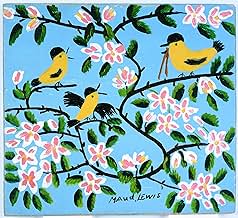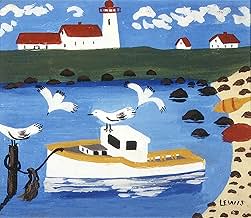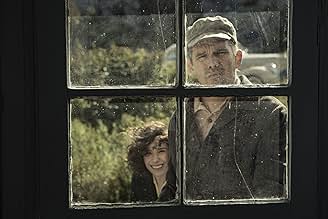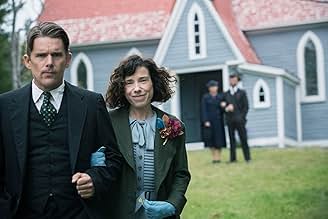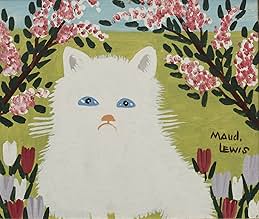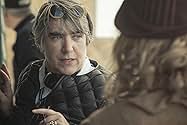एक गठिया-रोगी नोवा स्कोटिया महिला, एक नौकरानी के रूप में काम करते हुए, एक कलाकार के रूप में अपने कौशल को भी बढ़ाती है और आख़िरकार समाज में एक जानी मानी हस्ती बन जाती है.एक गठिया-रोगी नोवा स्कोटिया महिला, एक नौकरानी के रूप में काम करते हुए, एक कलाकार के रूप में अपने कौशल को भी बढ़ाती है और आख़िरकार समाज में एक जानी मानी हस्ती बन जाती है.एक गठिया-रोगी नोवा स्कोटिया महिला, एक नौकरानी के रूप में काम करते हुए, एक कलाकार के रूप में अपने कौशल को भी बढ़ाती है और आख़िरकार समाज में एक जानी मानी हस्ती बन जाती है.
- पुरस्कार
- 25 जीत और कुल 17 नामांकन
- Nurse
- (बिना क्रेडिट के)
फ़ीचर्ड समीक्षाएं
The film picks up with Maudie, played with understated sensitivity by Sally Hawkins, as she struggles and fails to earn the respect of her family. Despite her severe arthritis, Maudie answers an advert for a live-in maid and runs away. She moves in with and eventually marries the crotchety Everett Lewis (Hawke), a fishmonger who manages to put on a grim smile but once over the film's 40+ year time span. After a time living in Everett's dimly lit squalor, Maudie relights her passion for painting using abandoned cork board and the walls of her new home to paint continuously.
The true-life Maudie was eventually considered Canada's most popular and prolific folk artist; though one could hardly tell given the solitude that follows Maudie throughout her life. In the film, she remains isolated, largely due to her debilitating arthritis and painful shyness around strangers. There's one awkward scene early on where Maud struggles to shuffle out of a doorway and stick her head out long enough to compliment a woman's shoes. In that moment we realize her deep desire to be both accepted and left alone.
The film aptly compliment's the artist's own frailties and unconventionality with a strikingly brittle and unconventional love story. Maud's warmth towards Everett is sincere and unconditional. She sees in him, a beautiful person - an outcast like her who has been made wild by the cruelties of life but nevertheless deserves her love. As open as Maudie is to the inner-beauties of a warm sunset, Everett remains as cold and brutal as a winter storm. Yet every time he "puts a foot down," he wordlessly capitulates. He grumbles and erupts in objectively despicable behavior but Maud always seems to convince him that he's capable of love and being loved.
The film continues down this path of bittersweet co-dependence and as the relationship develops, we see the results of Maud's patience and virtue. Thanks to the remarkably assured cinematography of Guy Godfree, the film crackles with natural beauty and warmth of a cozy hearth. There are some truly breathtaking natural vistas on display here, which despite their expanse manage to feel intimate and idyllic.
As a film Maudie is certainly within the ranks of Mr. Turner (2014), My Left Foot (1989) and Lust for Life (1956). Much like those films, Maudie centers on the life of a tortured artist whose personal story tells something truly meaningful about the human condition. It also has a truly award-worthy performance by Sally Hawkins who is at this point in a class of her own.
Maud Lewis was a pioneer of the Art Naïve school of folk painting flourishing all over, especially in Canada, and specifically here in Nova Scotia. The quote shows how natural her genius was looking out a window from her 10x12 foot home.
The biopic Maudie thrives on Hawkins' superior acting talent that superficially shows her deformed leg, her debilitation from arthritis, and her emphysema doomsday from smoking. Yet she radiates joy and a keen eye for the simple beauty of life. As she tells her husband, Everette (Ethan Hawke), she doesn't need much.
With no formal artistic training, Maud initially uses a finger to paint a tulip with vibrant colors. She barely looks back as she paints chickens, dogs, birds, and "things," all observed inside and outside the humble cottage on doors, windows, boards, and whatever.
The pain most artists experience in order to express beauty comes for Maud not just from her physical handicaps but from her husband, a rude fishmonger and wood chopper without a lick of humor. He begrudgingly allows her to sell her paintings and pockets the proceeds. However, he loves her in his own crude way and provides the home, albeit no more than two rooms, that spawns the art.
Cinematographer Guy Godfree captures the sweep of open nature that surrounds the town and the intimately colorful interior transformed by her art. John Hand's production design makes her cottage so meticulously authentic that you might wonder if he borrowed it from the Nova Scotia museum that now houses
it.
Beyond the pleasant bio of a charming painter, the love between the two is one of the best romances of the year. It could be because theirs is hardly conventional or because Hawkins and Hawke are super actors. Or both. Love abides, and as Everett says, "There's me. Them dogs, them chickens, then you."
Sally Hawkins was absolutely great. With that shy but ready smile and wondering eyes. Although I felt kind of sorry for the way they portrayed her husband. Not sure if he was as brute in real life as they made him. Not that I know, of course, but it felt too much (and he looked smiley enough in the documentary bits). Also, I'd say the editing was not as smooth as it could have been so felt rather amateurish overall, but maybe that was intentional.
"Maudie" is a movie about folks, especially one very important central figure who happens to be a folk artist. Maud Lewis is her name, and it's very likely she never classified her art by any term whatsoever during her life, much less folk art. Her art is just something she did.
"Maudie" is a sweet little biopic movie that at times is a bit disturbing. The disturbing aspects are subtle. The creators/directors gloss over some of the finer points of her life, with some alterations of the truth. However, the important questions are asked, literally, during the movie. It's up to the viewer to see these aspects, or not, and take them for what they are. Your reactions or discernment thereof may depend on prior knowledge or research of the subject.
What is clear from almost the outset the movie, is that Maud and her husband led a difficult life - not quite but almost abject poverty. Yet Maud filled her life with beauty through her art. Flickers of relative fame touched her life briefly, but it was not until well after her death in 1970 that full appreciation was recognized, not that she really cared about these things.
"Maudie" is a small movie with big performances by the mains, especially Sally Hawkins. In my opinion, her performance as Maud is the best this year so far, but I can guarantee right now that you will hear her name come Oscar time next year. Ethan Hawke is also exceptional as her husband Everett, although the role itself is a bit more static. The supporting cast - mostly unknowns - does well in more cardboard cut- out roles, but Matchett, a Canadian actress who you might recognize from some American TV roles does a nice job as one of her earliest patrons.
Will you like this movie? I don't know, but I loved it. It is what it is, not an action movie, but a small art-house drama/biopic of a very interesting and amazing person who lived most of her life in obscurity. This movie affected me not just during the viewing, with tears streaming slowly down my face, but well after. The tears that came were not only sad but also from joy at her creations, but most of all they stemmed from my belief that beauty and sweetness deserves beauty and sweetness and, well, Maud had very little of that in her life.
Many biopics have been made of famous people that rose out of obscurity or extremely challenging situations or disabilities to achieve greatness and renown. What really interested and touched me about Maud's story is there was no rise.
(Interesting side note: Maud sold her paintings during her life for a few coins to a few dollars at most. Now her paintings are selling for six figures)
क्या आपको पता है
- ट्रिवियाThe fully restored house of Maud Lewis is on permanent display in Halifax at the Art Gallery of Nova Scotia. The decorated house was saved from deterioration by a group of concerned local citizens, that went through a 25 year-long struggle to maintain the house.
- गूफ़The paint "tins" that Maudie is using look like modern aluminum pull-tab type containers not old sardine tin cans.
- भाव
Mr. Davis (Shopkeeper): I don't know why people pay money for these, my five-year-old could do better.
Everett Lewis: Maybe. Maybe he could, but he didn't - Maud did. Brushes, please.
[slaps the coins on the counter]
Everett Lewis: You're an idiot.
- क्रेज़ी क्रेडिटA brief clip in the end credits shows the real Maud Lewis with husband, Everett, from a 1976 black and white short, "Maud Lewis: A World Without Shadows."
- साउंडट्रैकWinding Back the Years
Written by Anders Lewén (as Anders Johan Greger Lewen)
Courtesy of FirstCom Music
टॉप पसंद
- How long is Maudie?Alexa द्वारा संचालित
- How can I watch Maudie movie for free?
विवरण
- रिलीज़ की तारीख़
- कंट्री ऑफ़ ओरिजिन
- आधिकारिक साइटें
- भाषा
- इस रूप में भी जाना जाता है
- Maudie, el color de la vida
- फ़िल्माने की जगहें
- उत्पादन कंपनियां
- IMDbPro पर और कंपनी क्रेडिट देखें
बॉक्स ऑफ़िस
- बजट
- €49,93,020(अनुमानित)
- US और कनाडा में सकल
- $61,70,998
- US और कनाडा में पहले सप्ताह में कुल कमाई
- $45,920
- 16 अप्रैल 2017
- दुनिया भर में सकल
- $1,15,34,327
- चलने की अवधि1 घंटा 55 मिनट
- रंग
- पक्ष अनुपात
- 1.85 : 1
इस पेज में योगदान दें








